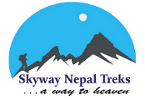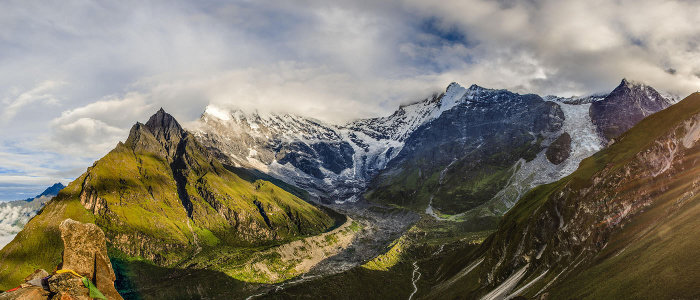
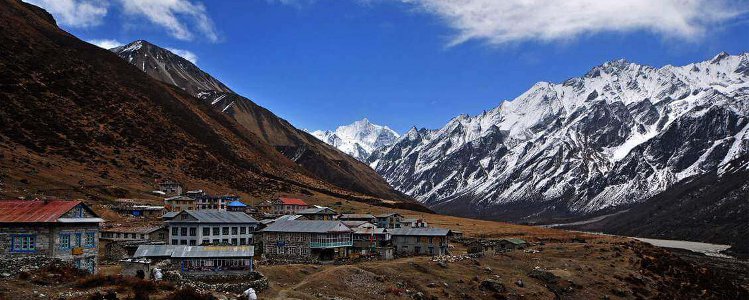
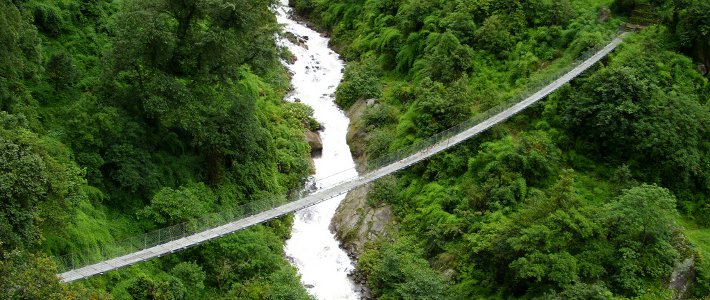
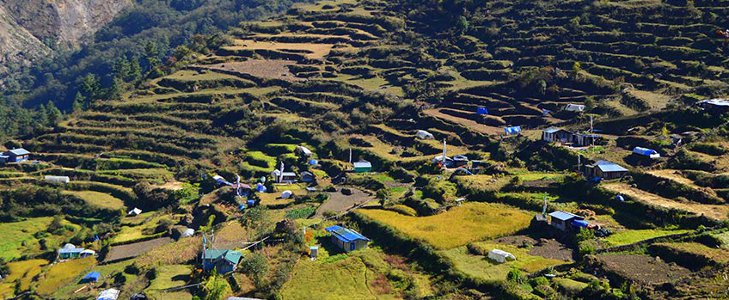
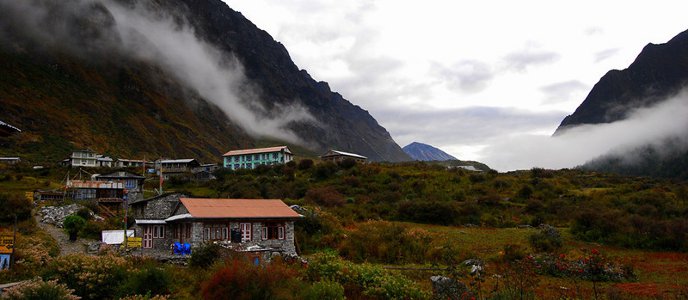
Langtang Valley Trek – 11 Days
Highlight
Trek on the picturesque Langtang valley to Kyanjin Gompa, enjoy stunning Himalayan views, and learn about rich culture in the region.
| Group size | 2 – 14 people |
| Trip duration | 11 days |
| Service level | Standard |
| Activities | Trekking and sightseeing |
| Maximum altitude: | 3,850m (optional hike to Tsergo Ri 4,982m) |
| Physical rating | Moderate |
| Arrival / Departure at | Kathmandu / Kathmandu |
| Transport: | Private vehicle between destinations for the activities included in the itinerary |
| Meals included: | Breakfast in Kathmandu; all meals during trekking; a welcome dinner and a farewell dinner |
| Accommodation: | 3-star hotels or equivalent in Kathmandu; teahouses during trekking. All accommodation is on a double occupancy basis |
| Age requirements: | 12+ (children under 18 must be accompanied by parent(s) |
Trip Description
Langtang region lies at the border of Tibet. This trip includes 6 days of trekking in the Lantang region with pine, rhododendron and bamboo forests as well as abundant wildlife. The views of the Himalayas will inspire you every day. We will encounter the rich culture of Tamang ethnic group and Tibetans.
We will also have an optional hike to Tsergo Ri (or Kyanjin Ri), either of which provides great views of the Himalayas and the Langtang valley.
The Kathmandu sightseeing tour will present you with four UNESCO world heritage sites. After the tour, you will agree the fine woodcarving and rich history of the shrines and temples are worth your visit.
Langtang valley was one of the worst affected by the 7.8 magnitude earthquake in 2015 with many settlements suffered substantial to catastrophic damage. The earthquake wiped the Langtang village off the map. Tourism helps the local people rebuild their lives in the area.
You may want to check out another short and easy trek in the same region: Helambu Trek 9 Days. If you prefer a longer trek, you may want to consider Langtang Valley Trek with Gosainkunda lake 15 Days.
Itinerary Outline
- -Day 1: Arrive in Kathmandu (1,300m)
- -Day 2: Kathmandu sightseeing and trek preparation. Optional: Everest Mountain Flight in the early morning
- -Day 3: Drive to Syabrubesi (1,460m, 7 to 8 hours hours)
- -Day 4: Trek from Syabrubesi to Lama Hotel (2,420m, 6 to 7 hours)
- -Day 5: Lama Hotel to Langtang Village (3,455m, 5 to 6 hours)
- -Day 6: Langtang Village to Kyanjin Gompa (3,850m, 2 to 3 hours). Explore Kyanjin Gompa
- -Day 7: Kyanjin Gompa - Acclimatization Day. In the early morning, optional hike to Kyanjin Ri (4,780m) or Tsergo Ri (4,982m) and back (3 to 4 hours)
- -Day 8: Kyanjin Gompa to Lama Hotel (2,420m, 5 to 6 hours)
- -Day 9: Lama Hotel to Syabrubesi (1,460m, 5 to 6 hours)
- -Day 10: Drive from Syabrubesi back to Kathmandu (7 to 8 hours)
- -Day 11: Depart or extend your trip. Optional: Everest Mountain Flight (if not taken on Day 2)
About Accommodation
We will stay in 3-star hotels or equivalent in Kathmandu, and teahouses during trekking. All accommodation is based on double occupancy. Single occupancy can be arranged at request with an extra cost. However, single occupancy may not be available at some teahouses during trekking in high seasons.
A teahouse is basically a combination of guest house, a restaurant, and social hang-out place. The guesthouses are usually basic, with twin beds in each room and very little additional furniture. Blankets are generally provided but you may want to bring a sleeping bag as the temperature can be much lower at night in mountains. Most bathrooms are shared with either squat type or western style toilets. Teahouses usually have running water and cold shower. Hot shower is available at some teahouses at an additional cost.
Each teahouse has a large dining room, served as a restaurant and a social gathering place, warmed by the bukhara stove (an iron cylinder, fitted with a chimney duct, in which a log fire is lighted). As some villages do not have hydroelectric power, the dining room and the rooms usually use solar lighting. Some teahouses have electricity for charging small appliances (mobile phones and cameras) at a small cost.
Free WIFI is available in the hotels in Kathmandu. During trekking, some teahouses provide WIFI at a small charge, but in some places WIFI is not available.
About Meals
During trekking, we will usually have breakfast and dinner at the teahouse we stay, and lunch will be provided at one of the restaurants we trek by. Every teahouse serves the traditional Nepali meal Dal Bhat (rice and lentils), as well as a variety of different food items such as rice, vegetables, noodles, potatoes soup, and western food such as pizza, pasta and French fries. Non-vegetarian option is usually available at low altitude levels. However, due to the storage issue, fresh meat is not available at some teahouses above certain altitude, but preserved meat (sausages, salami, etc.) may be served.
One tea or coffee will be served in each meal during trekking. Soft drinks, snacks and beer are available to purchase in most of the teahouses and restaurants along the trails.
In Kathmandu, breakfast will be provided in the hotels. You will also be treated with a welcome dinner and a farewell dinner at a nice Nepalese restaurant. This will give you an opportunity to enjoy a well-prepared traditional Nepalese food and dance performance.
About Drinking Water
Although bottled water is available to purchase on the trail, we don’t encourage the use of bottled water as the plastic bottles have a negative impact on environment. All teahouses provide boiled water for trekkers at a small cost. Bring your own re-usable or thermal bottles. Thermal bottles can also keep the beverage warm which is a delightful treat to your stomach in trekking when the temperature is low, Water filtration or chemical disinfection can be another option.
Physical Condition & Experience Requirements
This trek is a moderate trek which is manageable for people who are able to walk for around 5 to 6 hours a day with a light daypack. People with pre-existing medical conditions such as heart or lung diseases or high blood pressure should inform Skyway Nepal Treks staff before booking the trek. Consultation with your doctor is highly recommended. Travelers are encouraged to exercise and walk or hike regularly for a few weeks before the trip. To enhance strength, travelers could simulate the trekking trip by hiking on difficult terrain with some level of elevation for a few hours and with a daypack containing a 3-5 kg load.
For this trip, spring (late-February to mid-May) and autumn (late September to early-December) are the best months. If you don’t mind colder weather, the winter season (late-December to January) is good for this trek with clear sky. Heavy rain during the monsoon season makes the months from June to August not suitable for this trek.
Booking Notes
- - A customized itinerary can be arranged upon request.
- - Alternative accommodation (luxury or budget level) may be available. Please ask before booking.
- - If you wish to arrive earlier or extend your stay, accommodation can be arranged for you. Ask us about trip packages and options for trip extension.
- - Ask us for optional tours and pricing. There are many exciting tours and activities that you may be interested. Please discuss with our staff before booking and after you arrive so that we can make necessary arrangements for you.
- - Currency exchange service is available upon request.
Day 1: Arrive in Kathmandu
We will pick you up at the airport and transfer you to the hotel. The rest of the day is free time to explore in Thamel, the commercial centre in Kathmandu.
In the evening, you will be treated with a welcome dinner, including traditional Nepali food and dance performance, at a lovely Nepali restaurant.
Before the dinner, there will be a brief meeting with your guide to go over some important matters regarding trekking.
If you need to rent trekking gear, make sure to talk to our staff after you arrive.
(Meal included: Welcome dinner. Accommodation: Hotel in Kathmandu)
Day 2: Kathmandu Sightseeing and Trek Preparation
Take an optional Everest Mountain Flight (1-hour) in the early morning, if weather permits.
- Optional:
- A Nepali special, <Everest Mountain Flight is a great way for travelers of all categories to witness the spectacular mountain scenery in the Himalayan range, especially for those who have a time constraint and those who do not want trekking.
- Shortly after taking off from Tribhuvan International Airport, some of the world’s famous mountains will be presented to you in sequence, and some of these glorious mountains are yet to be conquered: Gosaithan (8,013m), Dorje Lhakpa (6,966m), Gauri-Shankar (7,134m), Chugimago (6,297m), Numbur (6,956m), Karyolung (6,511m), Cho-oyu (8,201m), Gyanchungkang (7,952m), Pumori (7,161m), Nuptse (7,855m), and finally the world’s highest mountain Everest (8,848m).
- Floating over the snow covered world’s highest mountains Everest, Lhotse, and Makalu, the spectacular views of the Himalayas will make you feel on top of the world. This 1-hour scenic flight provides sensational flying experience, which will stay in your memory for the rest of your life.
After breakfast, take a guided tour in Kathmandu Valley to four UNESCO World Heritage sites. Explore Hindu and Buddhist temples, pagodas, palaces and monuments. Treat yourself with a feast of cultural heritage and finest artworks.
- Patan Durbar Square, also known as Lalitpur, is the oldest of the three royal cities in Kathmandu Valley. Patan is home to fine arts and famous for its rich cultural heritage. You will enjoy the beautiful woodcarvings and metal statues in Patan Durbar Square and learn about the history of this old royal palace.
- Swayambhunath, also known as Monkey Temple, is a great example of religious harmony in Nepal. Along with the oldest stupas of its kind in Nepal, there are numerous shrines and monasteries. Legend has it that the glory of Kathmandu Valley started from this place. This site overlooks Kathmandu Valley, providing a great panoramic view of the capital city. Let the playful monkeys that wander freely in the temple amuse you. If you are into art, take time to visit the Thangka Painting School located in one of the towers. The exquisite Tibetan Buddhist art form is a guaranteed eye-opener.
- Bouddhanath Stupa(or Bodnath Stupa), the largest stupa in Nepal, is one of the largest Buddhist shrines in the world. It is also the holiest Tibetan Buddhist temple outside of Tibet. Built in the 14th century, Bodnath Stupa is the centre of Tibetan culture in Kathmandu and offers rich Buddhist symbolism.
- Pashupatinath Temple, one of the holiest temples, is worshiped both by Hindus and Buddhists. It is the most important temple dedicate to god Shiva. It is believed those who die in Pashupatinath Temple are reborn as a human, no matter how they behave when they are alive. Thus, every year, many elderly Hindus come here in the last few weeks of their lives, to die and to be cremated on the banks of the sacred river Bagmati.
The tour will finish in the mid-afternoon. Then it will be free time for you to explore Kathmandu further. Walk on the narrow streets in Thamel and enjoy window shopping of Nepali specialties. You can also escape to the historical and tranquil Garden of Dreams for a pleasant stroll.
If you need to do last-minute shopping for trekking gear, feel free to ask our staff for assistance.
In the evening, organize your belongings as we will leave very early next morning.
(Meal included: Breakfast. Accommodation: Hotel in Kathmandu)
Day 3: Drive from Kathmandu to Syabrubesi
After breakfast, a private bus will pick you up at the hotel and drive you to Syabrubesi, the starting point of the trek. While the bus is taking us on the winding road, enjoy the great views of Mt Manaslu, Annapurna and Ganesh Himal. We will stay overnight in a small village Syabrubesi (altitude: 1,460m, 7 to 8 hours’ driving).
(Meals included: Breakfast, lunch and dinner. Accommodation: teahouse in Syabrubesi)
Day 4: Syabrubesi to Lama Hotel
Today we will start trekking from Syabrubesi to Lama Hotel. The trail involves uphills and downhills along the Langtang Khola river. After we walk through the rhododendron and oak forests, we cross a bridge over Langtang Khola, climb up a steep hill and arrive at the village Lama Hotel (altitude: 2,420m, 6 to 7 hours’ trekking).
(Meals included: Breakfast, lunch and dinner. Accommodation: teahouse in Lama Hotel)
Day 5: Lama Hotel to Langtang Village
The trail continues along the Lantang Khola. We will hike up the steep hill to Ghora Tabela (2,970m), a field where we will see the peaks of the Lantang range. The trail continues to ascend and the valley widens. Enjoy the beautiful mountain landscape and waterfalls. We will pass a few temporary settlements of herders and a Buddhist monastery, then reach the Tibetan-style Langtang village (altitude: 3,455m, 5 to 6 hours’ trekking).
(Meals included: Breakfast, lunch and dinner. Accommodation: teahouse in Langtang Village)
Day 6: Langtang Village to Kyangjin Gompa
As the trail takes us to higher altitude, we will take a slower pace today. We will pass some water mills, prayer wheels, Tibetan monuments, and mani walls that are made of stones with inscription of prayers. The largest mani wall in Nepal is also on this trail. Take time to enjoy the views of Mt Ganchempo (6,387m) and Langtang Lirung (7,234m) ahead of you.
We will stay overnight at Kyangjin Gompa (altitude: 3,850m, 2 to 3 hours’ trekking). Kyangjin Gompa is home to an important monastery in the Langtang region. After having lunch at the teahouse, we will explore the monastery and the surrounding areas. Enjoy the afternoon with fantastic mountain and glacier views of the Langtang region. We may also visit a cheese factory to learn about the manufacture of cheese and enjoy a bite of Yak cheese.
(Meals included: Breakfast, lunch and dinner. Accommodation: teahouse in Kyangjin Gompa)
Day 7: Kyangjin Gompa. Optional hike to Kyangjin Ri or Tsergo Ri in the morning
Today we will rest in Kyangjin Gompa. In the early morning, we will take an optional sunrise hike to Kyangjin Ri (4,780m) or Tsergo Ri (4,982m) and back (about 3 hours). When you are at the peak, enjoy the stunning views at the peak, and take time to take photos of the extraordinary views.
(Meals included: Breakfast, lunch and dinner. Accommodation: teahouse in Kyangjin Gompa)
Day 8: Kyangjin Gompa to Lama Hotel
We will start trekking down today and pass the forests and villages that we passed on our way up. Don’t forget to enjoy the views ahead of and behind you. We will stay overnight at Lama Hotel (altitude: 2,420m, 5 to 6 hours’ trekking).
(Meals included: Breakfast, lunch and dinner. Accommodation: teahouse in Lama Hotel)
Day 9: Lama Hotel to Syabrubesi
Today is the final day of trekking. It will be an easy downhill hike to Syabrubesi (altitude: 1,460m, 5 to 6 hours’ trekking).
We will have free time to explore the small town of Syabrubesi in the afternoon. For those who are looking for souvenirs, local handicrafts such as colorful aprons and shawls made by local women are a good choice.
(Meals included: Breakfast, lunch and dinner. Accommodation: teahouse in Syabrubesi)
Day 10: Syabrubesi to Kathmandu
After breakfast, our private bus will take us back to Kathmandu (7 to 8 hours).
After checking in the hotel, you may want to shop in Thamel for gifts and souvenirs before heading back home next day.
In the evening, you will be treated with a farewell dinner and Nepali dance performance. Make sure this time you entertain yourself by following the dance performers’ lead to learn Nepali traditional dance.
(Meals included: Breakfast and farewell dinner. Accommodation: Hotel in Kathmandu)
Day 11: Depart or extend your stay
Depart at any time. Our staff will drop you off at Tribhuvan International Airport.
If your flight is in the afternoon, the optional Everest Mountain Flight could highlight the day for you if you did not have a chance to take on this once-in-a-lifetime adventure on Day 2. Ask our staff about it when booking this trip.
- Optional:
- Everest Mountain Flight (see details in Day 2)
(Meals included: Breakfast. Accommodation: None)
Price Includes
- -Airport / hotel transfers
- --Private vehicle between destinations for the activities included in the itinerary
- -All accommodation on a double occupancy basis
- -Trekking Permit and TIMS fees
- -All meals during trekking, all breakfasts in Kathmandu, one welcome dinner and one farewell dinner
- -Duffle bag for trekking (to be returned after the trip)
- -Experienced English-speaking trekking guide and a team of porters (one for every two clients) and assistants during trekking
- -Entrance fees and an English-speaking guide for the Kathmandu sightseeing tour
- -Insurance for the trekking guide and porters
- -First aid kit (carried by the trekking guide)
- -All applicable taxes
Price Excludes
- -International flight, travel insurance, visitor visa fee
- -All optional activities
- -Meals not mentioned (please allow for $50-80 USD for meals not included)
- -Personal trekking gear (available for rent)
- -Personal expenses
- -Drinking water, snacks, hot shower and WIFI during trekking
- -Tips for guides and porters
- -Charges for excessive luggage
- -Any other extra costs due to unforeseen circumstances
Optional Activities to Book during the Trip
- -Everest Mountain Flight (Day 2 or 11)
Suggested Activities or Tours for Extended Stay
- -Bardian National Park
- -Chitwan National Park
- -Bhaktapur Tour
- -Nagarkot Sunset/Sunrise Hike with Bhaktapur Tour
- -Trishuli River Whitewater Rafting
- -Lumbini tour
- -Yoga Retreat
Required from you
- Prior to your arrival: in order to obtain the trekking permit for you, we will need a scanned copy of your passport ID page
- After you arrive, the following items are needed from you:
- (1) Three photos (passport size or smaller)
- (2) Travel insurance and emergency contact information
Weather Related
- Weather conditions in the Himalayas can change rapidly, which could result in alternations of the itinerary. Travelers need to be prepared for all weather conditions and changes in the itinerary if necessary. The group leader (or trekking guide) will take their best effort to make your trip experience enjoyable.
Risk Related
- The itinerary is designed to allow for adequate acclimatization. However, you may experience altitude sickness and oxygen deprivation on this trek. Be sure to consult with your travel doctor before your trip. If the group leader (or trekking guide) deems it is unsafe for you to continue trekking at any point, you may be arranged to descend to a lower altitude or required to terminate the trek.
- Due to the nature of this trip, the activities included may involve some degree of risk. Obtaining travel insurance is highly recommended.
Baggage Related
- Baggage requirements:
- (1) Domestic flights: maximum 15 kg for check-in and 5 kg for carry-on for each passenger. Excessive weight could be charged for an extra fee.
- (2) Porters during trekking: One porter will be assigned to two clients. Each porter will carry a maximum weight of 25 kg (12.5kg for each client, in a duffle bag or a backpack)
- A duffle bag will be provided to every two clients. You may want to bring a few smaller soft bags to keep your belongings together and tidy before putting them in the duffer bag.
- If you don’t have your own trekking gear (trekking poles, sleep bag, etc.), you can rent them in Kathmandu. Talk to our staff after you arrive (A sleep bag is recommended as nighttime temperatures in mountains can be low. Wearing a down filled or fleece jacket in sleeping can also keep you warm).
Clothing
- Down jacket, 1
- Waterproof jacket, light weighted, 1
- Water proof pants, light weighted, 1 pair
- Hiking pants, light weighted, 2-3
- Base layer top, wool or synthetic, 2-3
- Base layer bottom, wool or synthetic, 2
- Middle layer top, fleece or other light weighted material, 1-2
- Middle layer bottom, fleece or other light weighted material, 1
- Short sleeve T-shirt, 2
- Shorts, 1
- Underwear
- Other casual clothing (for non-trekking use)
- Plastic bags (for wrapping clothes), a few
Footwear or Other Clothing Accessories
- Hiking boots, 1 pair
- Walking shoes or sport shoes, 1 pair
- Slipper, 1 pair
- Thick wool or synthetic socks, 2-3 pairs
- Light socks, 2 pairs
- Gloves, warm and water proof, 1 pair
- Light gloves, 1 pair
- Handwarmer, a few packs
- Soap/ laundry hanger or clips/ rope
- Shoulder bag (light weighted, for non-trekking use)
Trekking Gear
- Day pack
- Soft bags (1-3) (to put belongs in Skyway’s duffle bag during trekking)
- Sleeping bag
- Sleeping bag liner
- Reusable water bottles or hydration pack (Camelbak)
- Water filter or disinfection tablets (nice to have)
- Light weighted thermal bottle (nice to have)
- Head lamp or flashlight with some batteries
- Sunglasses
- Sun hat
- Headscarf or bandana
- Walking poles
- Gaiters (nice to have)
- Raincoat (nice to have)
- Travel knife (nice to have)
- Small pack of duct tape (nice to have)
Personal Hygiene and Skin Care
- Personal Hygiene kit
- Skin care products
- Hand sanitizer
- Sunblock
- Lip balm
- Hand moisturizer
- Drying towel, light weighted, 1
- Small face towel, 1
- Travel tissue pack, a few packs
- Toilet paper (a few rolls)
- Nail clipper
Food and Snacks
- Dried meat
- Nuts
- Chocolate
- Energy bars or other snacks
- Chewing gum
Documents and Money
- Flight e-ticket
- Passport and a copy of ID page
- Passport-size pictures, 4 (1 for visa application and 3 for the trekking documents)
- Cash (for trip cost balance, tips, meals not included, personal expenses, shopping)
- Credit card / debt card
- Money belt
- Travel insurance policy document and contact
- Emergency contact information
- Hotel name in Kathmandu (need it when filling out Arrival Card at the airport)
- Travel agency’s contact info
Medicine and First Aid
- Medicine prescribed by the travel doctor
- Prescription medicine (if any)
- Band aids
- Callus cushion (for callus and blisters)
- Advil or Tynol (for headache, dry cough and cold)
- Gravel (for nausea)
- Halls or other medicine (for sour throat)
Electronics
- Multi-volt adaptor (click here for electronic outlet information in Nepal)
- Camera, charger, backup batteries and backup SD memory card
- Cellphone and charger
Everest Region Trekking
- Everest View Trek – 12 Days
- Gokyo Lakes and Gokyo Ri Trek – 15 Days
- Everest Base Camp Short Trek – 16 Days
- Gokyo Lakes and Gokyo Ri Trek with Tengboche – 17 Days
- Everest Base Camp Trek via Gokyo Lakes – 19 Days
- Everest Base Camp Three-Pass Trek – 21 Days
- Everest Base Camp Trek via Jiri – 24 Days
- Everest Base Camp Trek via Jiri and Gokyo Lakes – 27 Days
Annapurna Region Trekking
- Ghorepani-Poon Hill Sunrise Trek – 10 Days
- Annapurna FoothillsTrek – 12 Days
- Jomsom – Muktinath Trek – 13 Days
- Annapurna Base Camp 15 Days
- Khopra Danda Trek – 15 Days
- Annapurna Circuit Trek – 16 Days
- Upper Mustang Trek – 16 Days
- Annapurna Base Camp Trek and Chitwan Tour 17 Days
- Manaslu Larke Pass Trek – 18 Days
- Annapurna Circuit Trek – 20 Days
- Annapurna Circuit Trek with Tilicho Lake – 21 Days
- Tsum Valley and Manaslu Trek – 25 Days
- Manaslu and Annapurna Circuit Trek – 26 Days
